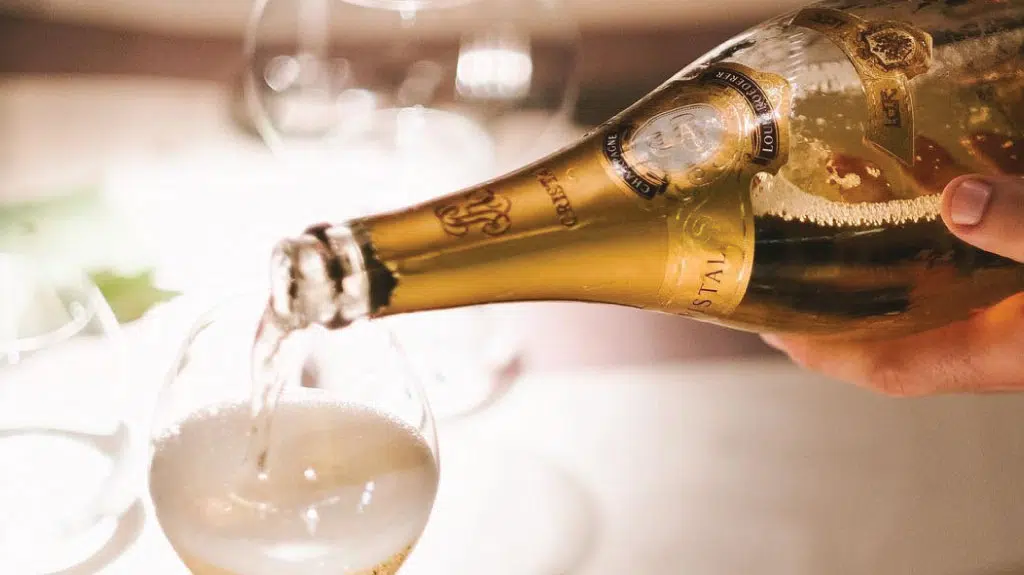Champagne and Sparkling Wine Guide

Every occasion calls for some celebratory sparkling wine! Whether you prefer classic Champagne, or an easy, cheerful sparkling wine, there is no lack of either! If you’re curious to know more about the traditional Champagne and sparkling wines, this piece is for you. It should come as no surprise that the British have been loyal fans of all kinds of sparkling wine since the very beginning, and we don’t blame them. These are some of the finest wines in the world.
The important difference to note between Champagne and sparkling wines, is that all Champagne is sparkling wine, but not all sparkling wine is Champagne.
Champagne and the Methode Traditionelle
Champagne has quite a number of rules and regulations governing it. For starters, it can only come from the region of Champagne, which is to the north of France. The vines here were originally cultivated by the Romans almost 400 years ago. There are only a handful of grapes that are legally allowed to be used to make champagne: Pinot Noir, Pinot Meunier and Chardonnay. There are also very strict guidelines on the method of production. The method used is called the Method Champenoise (Champagne method) or Methode Traditionelle (Traditional Method). In South Africa, the term is Method Cap Classique.
Most quality wine retailers of the world tend to stock at least one of these fine sparkling wines.
This is how champagne is made:
The grapes have to be picked by hand, when they just started to ripen to ensure the acidity is retained. Using these grapes, a still, neutral wine is made and fermented in large, steel tanks.
With most of Champagne’s wines, the wines are then blended for consistency. A new wine may be blended with an older vintage or one grape neutral wine (Chardonnay) may be blended with another (Pinot Noir). Usually, most Champagne DO NOT HAVE VINTAGES because of this blending activity.
This blended neutral wine is then bottled together with some sugar and yeast for a SECOND fermentation that occurs inside the bottle. That bottle, and it is this bottle in which the wine will be sold in.
Once the fermentation is complete, the dead yeast cells are left in there for a while to add complexity and this is where that toastiness of Champagne comes from. This is known as “lees ageing,” which is what gives Champagne its distinct flavours and aromas.
When the lees ageing is complete, these yeast cells are removed from the bottle. This is done by turning the bottle upside down, letting the cells drift to the neck where they are frozen and removed.
At this point, there is some liquid missing from the bottle that we have to fill. This is filled with either dry neutral wine for a brut or a sweet neutral wine for a doux. So, depending on how the champagne is made and what liquid is used to top it up, the champagne can either be dry or sweet.
The cork, cage and foil is added and the champagne is required to age in the bottle for a few years before this fine wine can be distributed to wine retailers and other alcohol retailers.
Other champagne-style sparkling wines
Historically, it was thought that the French monk Dom Perignon is the person that invented Champagne but this is not true. The production of sparkling wines was recorded decades before Don Perignon produced the wine. He was, however, responsible for the iconic ‘blanc de blanc’ wines. Also, as a fun fact, Dom Perignon, which is produced by the Moet and Chandon House, are one of the few French champagnes that have vintages on the labels. These wines are so revered, that they carry a hefty price-tag with it. And has the price tag to show for it.
Essentially, winemakers around the world make Champagne-style wines, but unless it comes from the region of Champagne, it cannot be called Champagne. This is true, even if the exact same grapes and methods are used.
These Champagne-like wines often produce spectacular quality. In fact, in many international wine competitions, these sparkling wines were received awards that traditional French Champagne producers did not. Wine retailers, judges and avid wine lovers all agree that, fine sparkling wine is not limited to the borders of France.
So, don’t shy away from other countries who produce make wines similar to Champagne. Although they don’t carry the age-old Champagne reputation, these wines prove to have both the quality and complexity you expect from traditional champagnes. And as an added benefit, they are usually a fraction of the price. If I can have a great Champenoise style wine at half price then that’s a plan I’m down with! A good example of this is the Australian made Madeline Alice or the Steenberg 1682 Brut. Most wine retailers will agree that these are both fantastic examples of fine sparkling wines outside of the Champagne region.
Hesketh Madeline Alice made with Chardonnay and Pinot Noir grapes in Champagne style.
PROSECCO
Prosecco is an Italian Sparkling wine made in the North-eastern part of the country. By law, only wines produced in this region of Italy are allowed to be labelled as ‘Prosecco.’ This is their ‘Champagne’. Unlike Champagne, where a few different grape varieties can be used, Prosecco can only be made from a grape called Glera. Which used to be called Prosecco! The method used to produce Prosecco also differs from that of Champagne, and is a lot less labour-intensive. The wines produced may not be as complex as the Traditional Champenoise style, but they are not meant to be. Prosecco is all about the freshness and fruitiness and is a fine wine in its own form.
OTHER SPARKLING WINES
There are other sparkling wines including Cava from Spain, Sekt from Germany and even Crémant in France. These sparkling wines are all made in some unique way; whether it be the same as Prosecco or even Champagne-like.
HOW TO ENJOY SPARKLING WINE AND CHAMPAGNE
Sparkling wine should be served properly chilled. If you can, get it between 6 to 10 degrees centigrade. The Champagne flute is the best glass to serve sparkling wine as it helps preserve the bubbles for longer. The saucer-glass (which was all the craze during the 20s) used to be the popular glass to enjoy this fine wine. This is because the larger bowl-like glasses help release all the incredible aromas.
The champagne flute is the best glass to serve sparkling wine in as it helps preserve the bubbles for longer. Which is why we are drinking sparkling wine in the first place isn’t it?
As for food pairing, if it’s a dry/ brut, try pairing with oysters or fried chicken (KFC anyone?) A sweeter style can be paired with dessert or of course a wedding cake. Either way, these fine wines can be enjoyed with simple food or some of the world’s most delicate dishes.
Cheers to good times and good people!
Cool Sparkly Terms To Know
BRUT NATURE– Super Dry.
BRUT– Very Dry.
SEC- Dry (but technically has a little residual sugar.)
DEMI SEC– Medium Dry.
DOUX – Sweet.
VINTAGE- Sometimes, when the year was really good, producers will actually produce a vintaged sparkling wine.
BLANC DE NOIR- A white sparkling wine made out of red grapes e.g. Pinot Noir.
BLANC DE BLANC – A white sparkling wine made out of white grapes (Chardonnay.)
